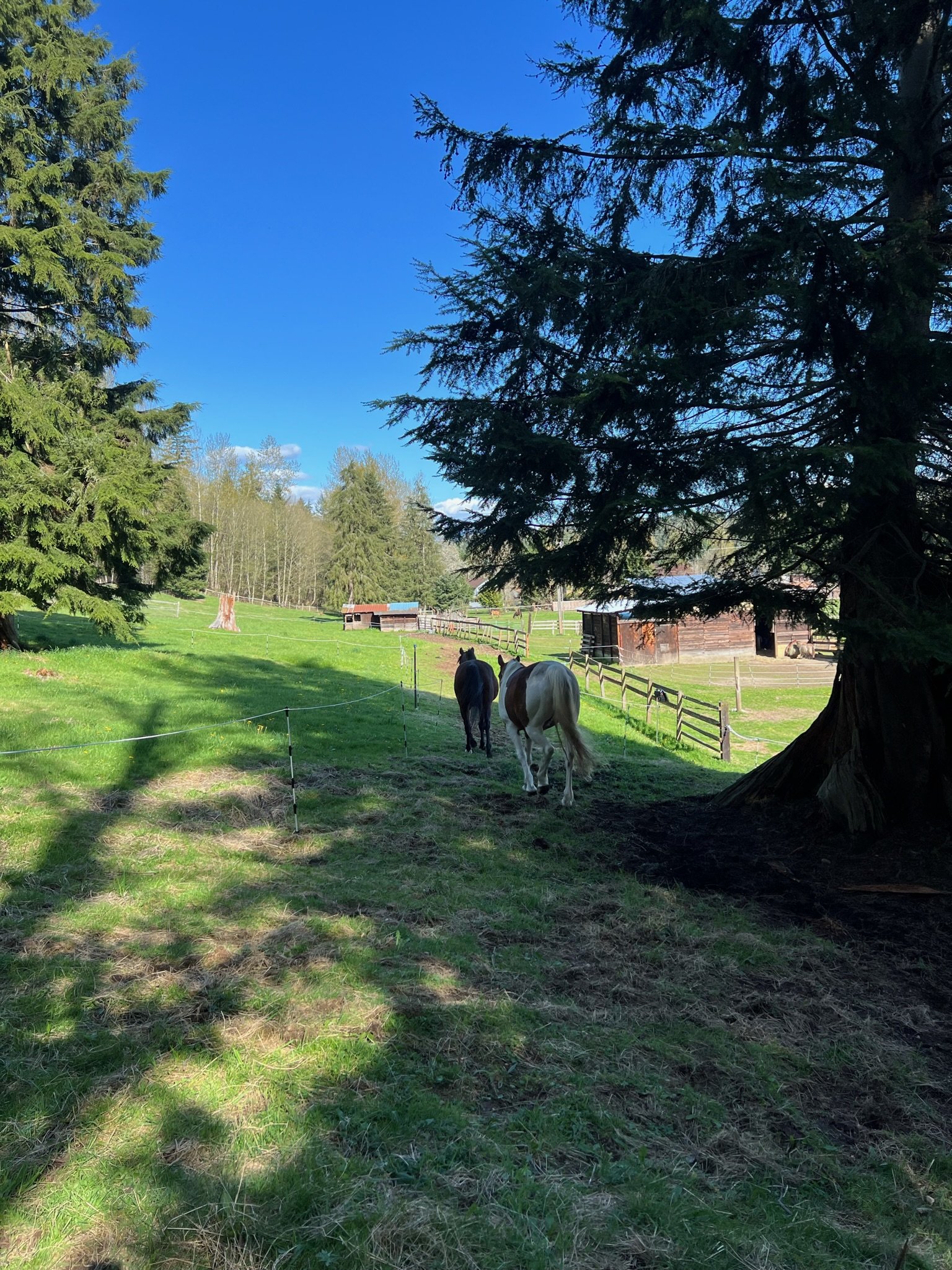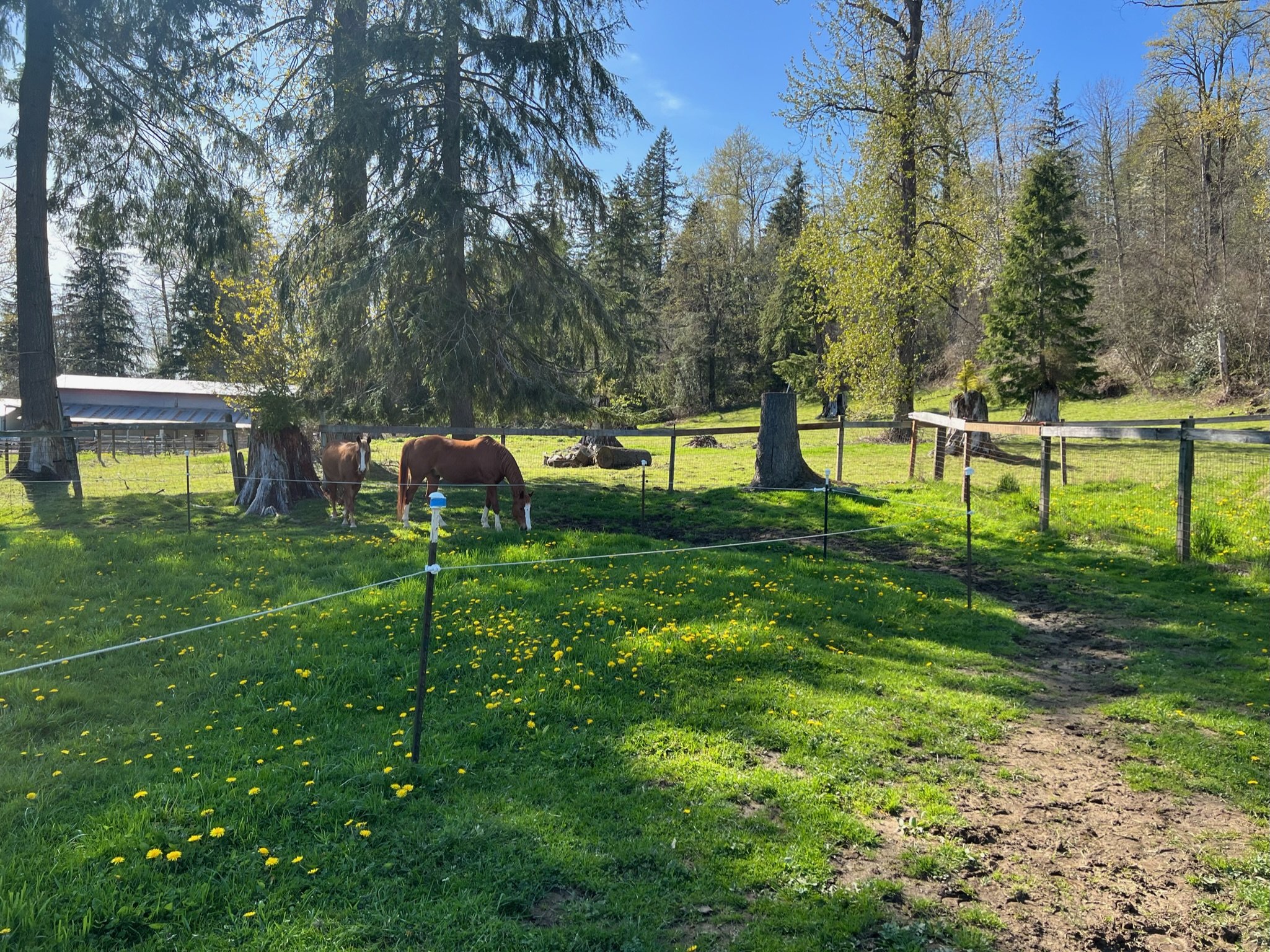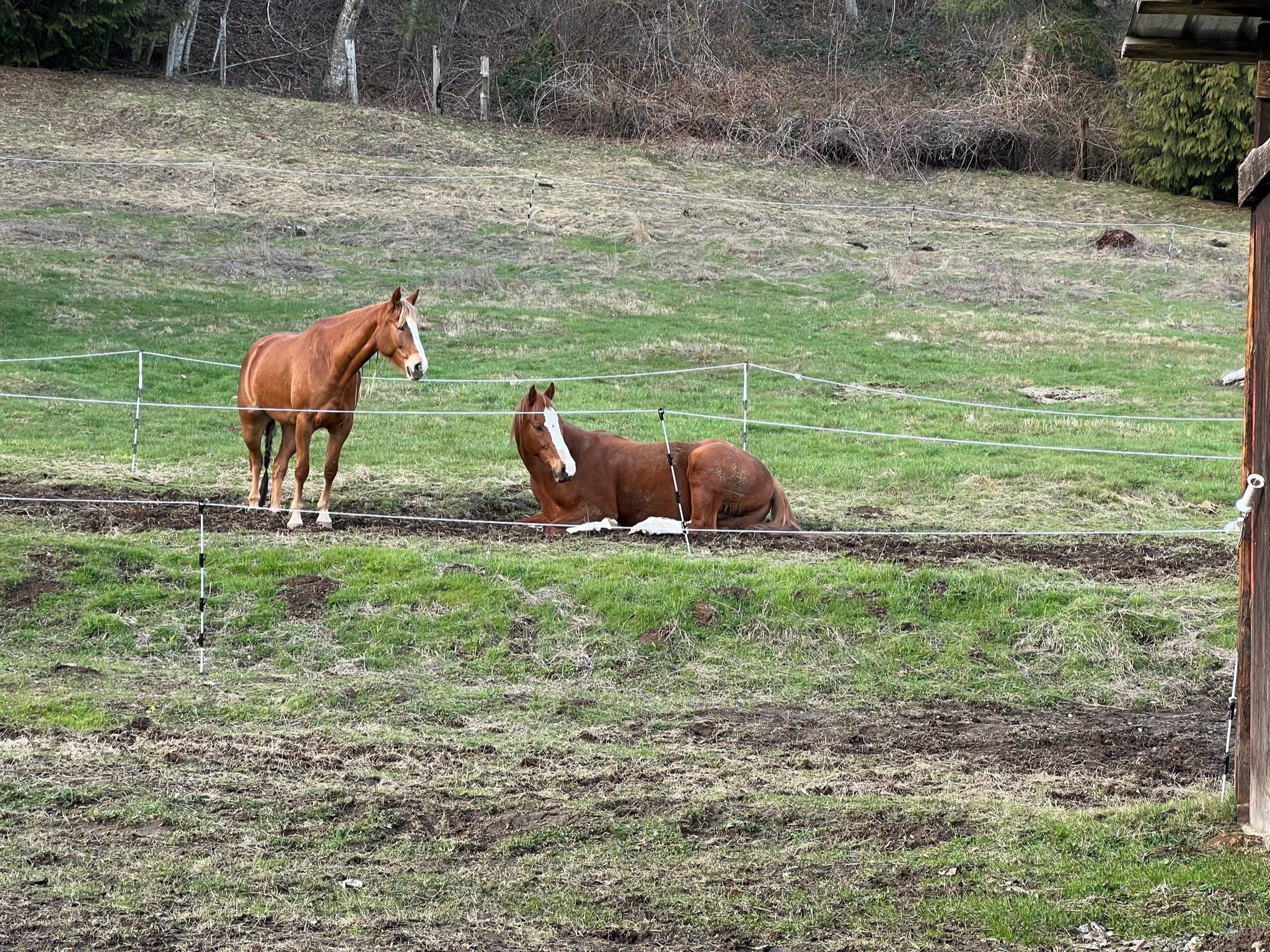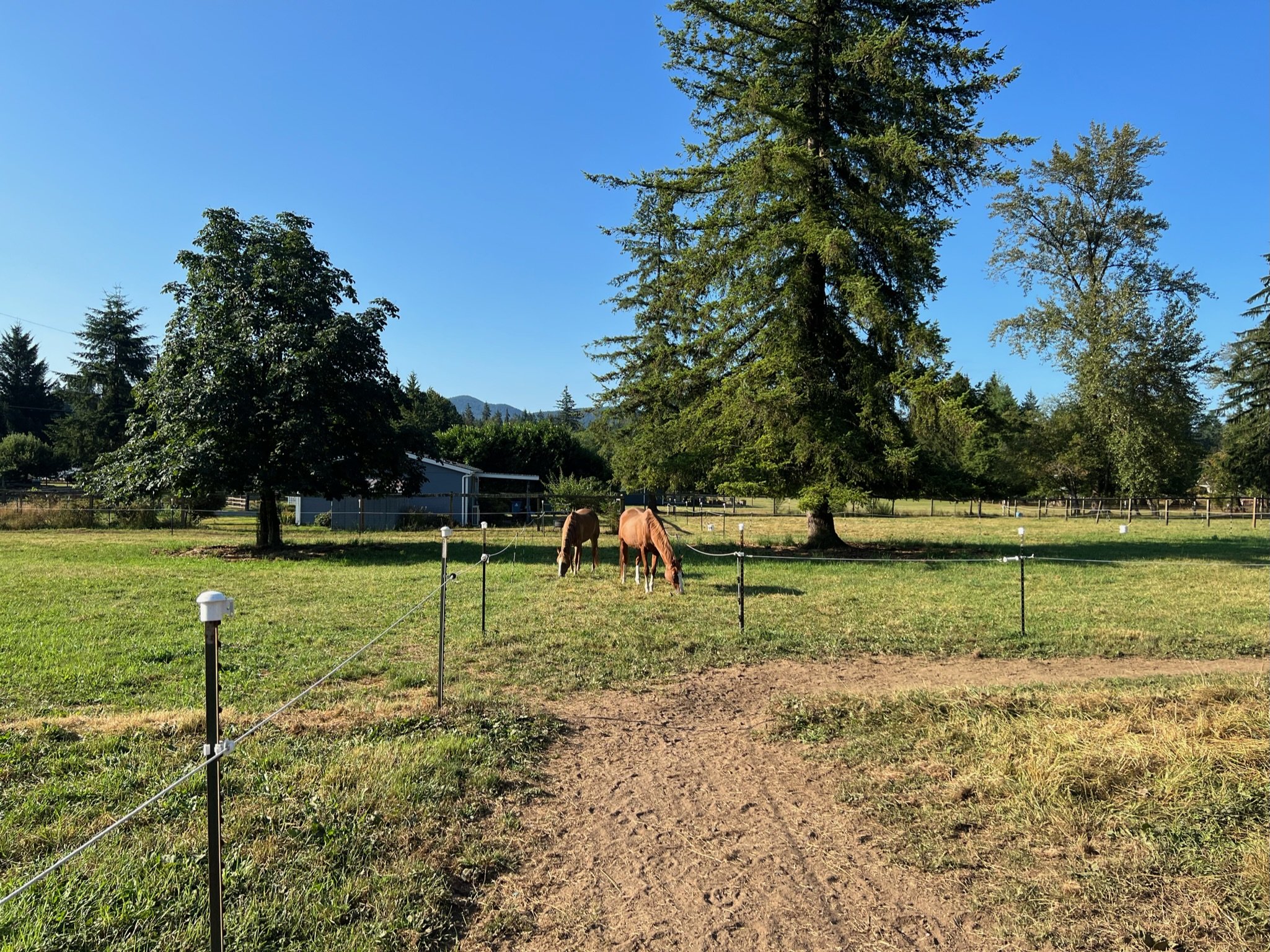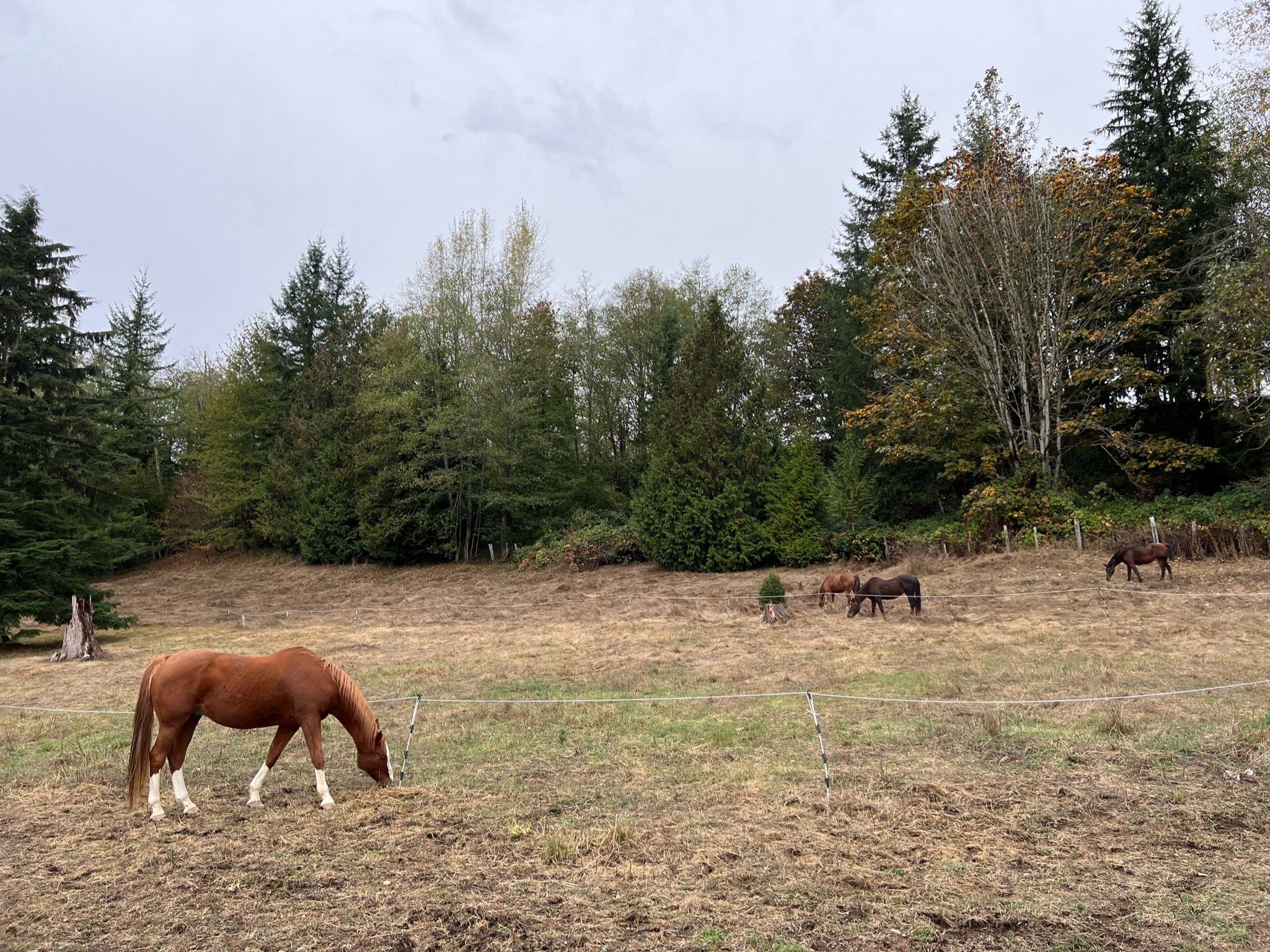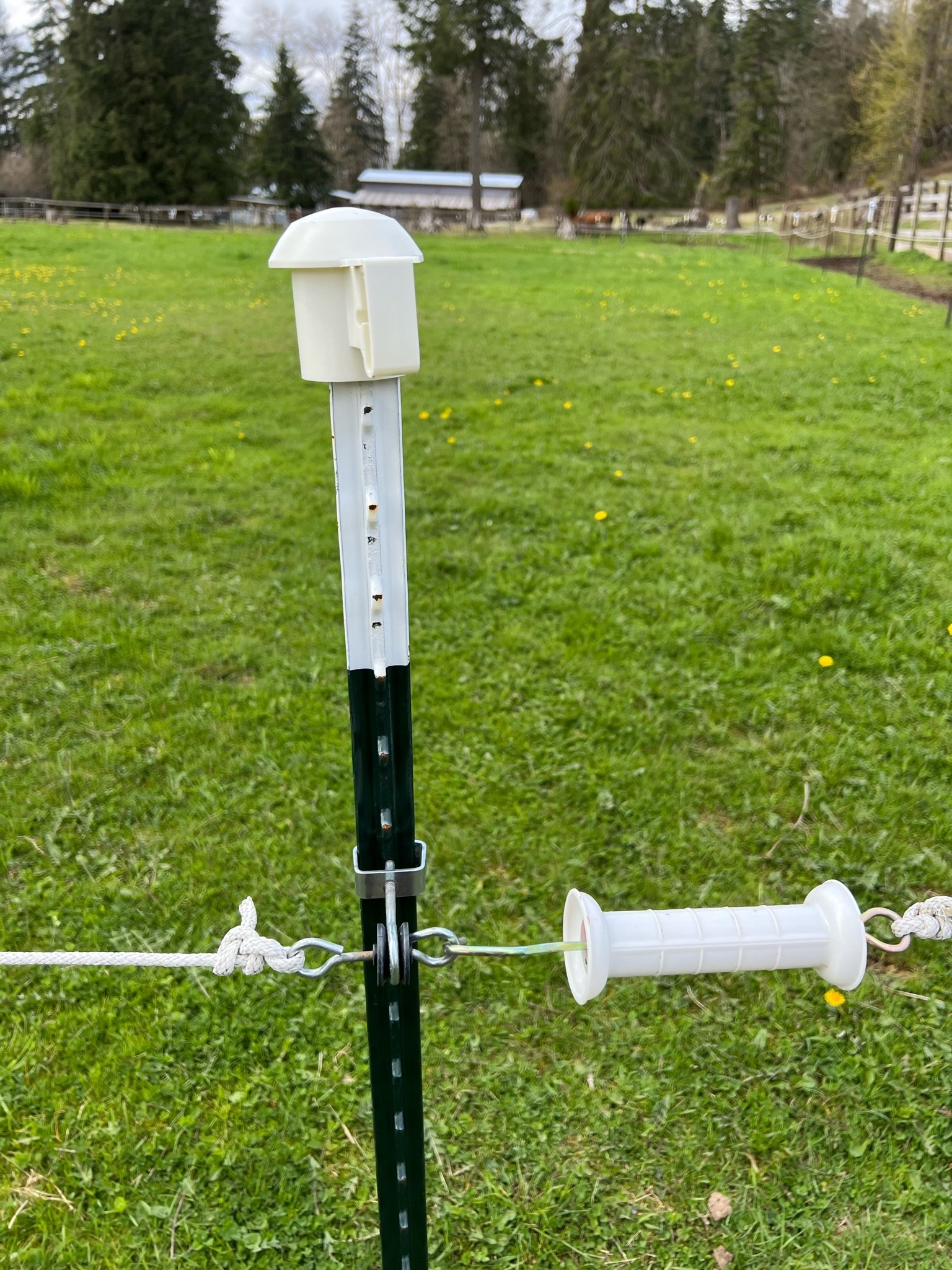Track Paddock Highlight with Sarah and Jeremy Vecchi
/Before we begin
Note: If you do put in a track paddock and it contains grass, the same grazing rules apply as on a pasture, particularly for easy-keepers. We recommend following standard precautions of slowly increasing time on grass, grazing early in the day when sugars are low, and using grazing muzzles as needed. Alternatively, grass can be removed and replaced with footing. If you are interested in installing a track paddock or want to know if your site is suitable for one, click here to contact a Snohomish Conservation District farm planner.
Horse owners may vary widely in their styles and approach, but there’s one thing just about everyone agrees on: they want their horses to be happy. Sarah and Jeremy Vecchi are no exception. Even before they bought their five-acre horse property in Monroe, they were already thinking about ways they could provide enrichment.
“We wanted them to have movement and the freedom to choose how to spend their time, and to have their social needs met living in a herd,” Sarah said.
At the same time, it was important to Sarah and Jeremy to build healthy pastures—not just for forage, but for soil health and carbon sequestration. Both had a familiarity with permaculture and were interested in ways they could create a green horse property. While they wanted to give their horses space to move, they knew that if they gave them unlimited access to pastures year-round, it would lead to compaction and overgrazing, giving way to weeds and mud mixed with manure. And those conditions don’t make horses happy either.
Sarah first learned about track paddocks while boarding at a facility and realized it could be exactly what they were looking for. She started doing research by first reading Jamie Jackson’s book, Paddock Paradise, and then joined some Facebook groups focused on track systems. (Check out the links to these and other resources from Sarah and Jeremy at the end of this article.)
“Those groups were a really great place to get inspiration, advice, and feedback,” Sarah said. “Finding other people from the Pacific Northwest was especially helpful since they were dealing with a similar climate. Our environment here is significantly different from the high desert where Jackson sets his Paddock Paradise.”
In December of 2021, Sarah and Jeremy finally bought their own horse property. Since it was previously a small thoroughbred breeding facility, it already had three large, fenced pastures. While it was a huge advantage to have existing pastures with six-foot perimeter fencing, the grazing quality had room for improvement. One of their early steps was to have Snohomish Conservation District’s Agriculture Department Director, Bobbi Lindemulder, out for a site visit.
“We had a ton of help from Bobbi, doing soil testing for us and advising on things like how much lime to use and how to manage things like buttercup,” said Jeremy. “I put a lot of time into seeding, mulching, and mowing.”
While they began rehabilitating the pastures, Sarah and Jeremy started mapping out their plans for a track paddock. They started by putting a track around the perimeter of one of their three fenced pastures. Then they wanted to turn the interior of the pastures into grazing units that they could rotate the horses through when the grass was ready. Jeremy used the satellite view in Google Earth to draw the possible layouts.
“We spent a lot of time walking the pastures with measuring tape in hand, putting markers in the middle of the field. We then added the step-in fence posts and polybraid, which were great because they allowed us the flexibility to try different things and make it wider or narrower and adjust as needed.”
The Result
After adding a track around the second of their three pastures, the total track length ended up being about a third of a mile, with many “gates” in the interior fencing that can be opened as needed to allow horses to graze their pasture units during the growing season when the grass is at least six to eight inches tall.
“The track is at least 12-feet wide everywhere, and we made the corners kind of rounded so there were fewer sharp angles. Four horses is the max we've had so far on our system, but we think we can comfortably accommodate a couple more,” said Sarah.
“We have a lower track that's between our house and the barn that connects to our upper track via our sand arena which has a covered round pen for shelter. Then it goes through a loafing area to another track that's on a hill, so it’s really fun for them.”
Track Paddock Maintenance
In order to prevent a track paddock from turning into mud, most people in the Pacific Northwest need to either add footing (such as sand, gravel, or mats) or limit access, particularly during wet weather.
“We haven’t been able to afford to surface the track, so we walk it every day to decide whether we're going put the horses out or not,” explained Sarah. “Factors to consider include recent precipitation, standing water, presence and condition of forage growing on the track, and any grazing restrictions required for horses prone to laminitis or insulin resistance. With the current state of our track paddocks, we often have to make the tough choice to keep the horses in their gravel runs or the sand arena.
Sarah also picks manure from the track weekly.
“Lots of folks don't pick manure or only drag their tracks, but I find that picking it regularly drastically reduces flies and mud. I use a long-handled heavy-duty dustpan and a shrub rake with a wheeled muck bucket. Since we only have four horses out there it’s manageable, plus it's a good workout for me.”
Is a Track Paddock Right for You?
While the Vecchis love their track paddock, they realize it wouldn’t work for everyone.
“One major thing to consider is your available time and money,” said Sarah. “Depending upon your particular design and needs, a track system can require daily planning and management. Since Jeremy works from home and I run the boarding business full time, we were relatively time rich and resource poor. That meant that we couldn't afford to surface the track immediately, and instead we have spent our available time in daily evaluation and more intense management of horses on the system.”
Each property is different, so figuring out whether your land is suitable for a track is an important first step. A farm planner from Snohomish Conservation District can help evaluate your soil and slope and provide advice on things like fencing, footing, and design. (Click here to contact a farm planner.)
The personality of your horses is another point to consider.
“Our horses are okay with one strand of very hot polybraid, but others may need more strands or something more permanent,” explains Sarah. “It also takes time to familiarize horses with a track and introduce them to a herd in that setting. We’re constantly evaluating their interactions to make sure everyone is safe.”
The Payoff
All the effort the Vecchis have put into building and maintaining their track paddock has been well worth it for them.
“Sometimes you see horses with a big pasture and they're just kind of standing there and not moving much,” said Sarah. “We were surprised by just how much exercise the horses truly get with the track and how some of the inseparable best buddies end up on opposite sides of the property, doing their own thing.”
Sarah has added in elements to encourage movement, such as hay nets hung along the fenceline.
“We’ve also taken some fallen tree limbs and laid them out along a straightaway, so it slows them down and gives them something interesting to have to navigate.”
“To me, I almost can't imagine doing it any other way at this point,” says Jeremy. “The horses just have so much freedom and seem to really enjoy themselves.”
Sarah agrees. “I’d encourage anyone to try it. It's not an all or nothing proposition—even if you have just an acre you can still set up a small system so they just get more movement. For some reason, taking the same space and turning it into a track just makes it so much more interesting for horses. It’s a blast watching them explore.”
Sarah and Jeremy’s Recommended Resources
Paddock Paradise: A Guide to Natural Horse Boarding by Jamie Jackson
Horse Track Systems: A ‘How To’ Guide to a Healthier Horse in Body and Mind by Amy Dell (This has a lot more specific guidance and examples than Paddock Paradise).
Facebook groups: Horse Track System, Paddock Paradise Track System, Track/Paddock Paradise/Enrichment Livery, and Paddock Paradise Tracks PNW
This project has been funded wholly or in part by the United States Environmental Protection Agency under assistance agreement PC-01J18001 to the Washington State Department of Health. The contents of this document do not necessarily reflect the views and policies of the Environmental Protection Agency, nor does mention of trade names or commercial products constitute endorsement or recommendation for use.
Three of the horses living at Sarah and Jeremy’s farm walk the track.





